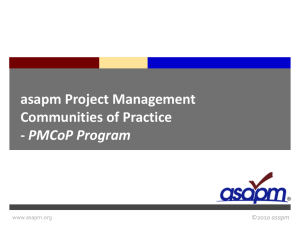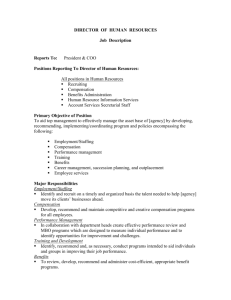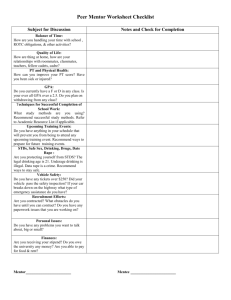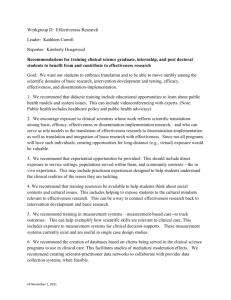our response - Manchester Disabled People`s Access Group
advertisement
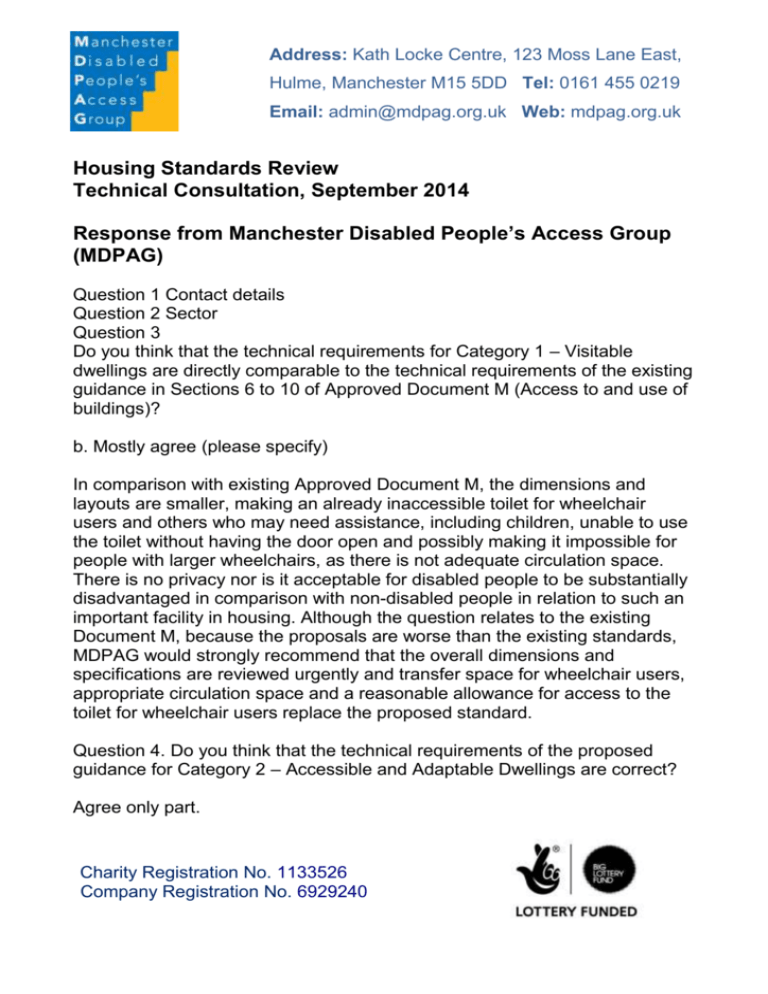
Address: Kath Locke Centre, 123 Moss Lane East, Hulme, Manchester M15 5DD Tel: 0161 455 0219 Email: admin@mdpag.org.uk Web: mdpag.org.uk Housing Standards Review Technical Consultation, September 2014 Response from Manchester Disabled People’s Access Group (MDPAG) Question 1 Contact details Question 2 Sector Question 3 Do you think that the technical requirements for Category 1 – Visitable dwellings are directly comparable to the technical requirements of the existing guidance in Sections 6 to 10 of Approved Document M (Access to and use of buildings)? b. Mostly agree (please specify) In comparison with existing Approved Document M, the dimensions and layouts are smaller, making an already inaccessible toilet for wheelchair users and others who may need assistance, including children, unable to use the toilet without having the door open and possibly making it impossible for people with larger wheelchairs, as there is not adequate circulation space. There is no privacy nor is it acceptable for disabled people to be substantially disadvantaged in comparison with non-disabled people in relation to such an important facility in housing. Although the question relates to the existing Document M, because the proposals are worse than the existing standards, MDPAG would strongly recommend that the overall dimensions and specifications are reviewed urgently and transfer space for wheelchair users, appropriate circulation space and a reasonable allowance for access to the toilet for wheelchair users replace the proposed standard. Question 4. Do you think that the technical requirements of the proposed guidance for Category 2 – Accessible and Adaptable Dwellings are correct? Agree only part. Charity Registration No. 1133526 Company Registration No. 6929240 MDPAG strongly recommend that Category 2 standards become the minimum standards and replace Category 1. We note that these standards are described as Accessible and Adaptable and our comments reflect concerns that some of the proposals are neither accessible nor adaptable. Approach routes 2.8.c We recommend that communal parts of the approach route should have a clear width of at least 1500mm (except communal stairs). Disabled people and older people, who may not describe themselves as disabled, or people coming out of hospital or needing medical treatment at home may need assistance with someone alongside them. There may also need to be space for someone with an assistance dog or someone using a mobility scooter as well as other pedestrians using the approach route. Emergency evacuation should also be considered and increased space allowed where there are disabled people using the approach route. In the current Approved Document M, a level approach for buildings other than dwellings, where there is communal use, requires a surface width of at least 1.5m (1.13). 2.8.f We do not agree that the gate should have a clear opening width of at least 850mm. We consider that this is not wide enough for disabled people using larger wheelchairs, people using large mobility scooters, people with assistance dogs and people who require assistance with walking. Communal doors used by the public in buildings other than dwellings in the current Part M, require a clear opening of 1000mm and we recommend that every gate (or gateway) has a clear opening of 1000mm in proposed Category 2. 2.9.a We believe that the gradient standard for ramps of 1:20 and 1:12 could make ramps too steep not only for manual wheelchair users but also for some disabled people who are walking up the ramp. We recommend that the gradient is between 1:20 and 1:15. 2.10.f We are concerned that the proposal includes handrails only to one side where the flight is not wider than 1000mm. Some people because of their impairments, require handrails to both sides, and we recommend that this is required for all flights with two or more risers. Charity Registration No. 1133526 Company Registration No. 6929240 Car parking and drop off 2.11.a We note that a standard parking bay should be capable of being widened to 3.3m. This is less than the dimensions of parking bays for disabled people in the current Part M standards. In order to be adaptable in the future, we recommend that all parking bays are capable of being widened to 3.6m. 2.11.b The proposal to have one side with a clear access zone of 900mm would be too small for people who use wheelchairs and some people who need additional space to exit their vehicle and is smaller than the current Part M standards. We recommend that there should be a clear access zone of 1200mm to one side (and a dropped kerb). It seems that the requirement of the dropped kerb intends that it could be used by wheelchair users and other disabled people requiring additional space for parking, such as people with prosthetic legs. It is therefore appropriate that sufficient space should be provided for the majority of users as already identified in Part M and BS8300. 2.12 MDPAG recommends that all dwellings are provided with a drop-off (or setting down point) with the provisions proposed. Communal entrances 2.13.a We do not agree with the proposal for a level landing of 1200mm wide and 1200mm long directly outside the entrance as we do not believe that this provides sufficient circulation space to approach and use door entry systems and to open doors. We recommend 1500mm x 1500mm as recommended for communal entrances to buildings in Part M and BS 8300. 2.13.b We also recommend to support our recommendation of 2.13a, that the landing is covered to a width and depth of 1500mm. 2.13.c We support the proposal that illumination is provided by lighting which is automatically activated on a dawn to dusk timer or by detecting motion but recommend adding that this should not be provided through the use of spotlights or uplighters, which produce glare and shadows. This is referred to in the existing Part M relating to buildings other than dwellings. 2.13.d, 2.13.e We do not agree with the proposal for a clear opening width of at least 800mm as this would be too narrow for some disabled people. We support the comments from Habinteg regarding the proposal relating to door Charity Registration No. 1133526 Company Registration No. 6929240 ironmongery. We also recommend that the clear opening needs to be at least 900mm and preferably 1000mm, as is recommended in the existing Part M for buildings other than dwellings. 2.13 General point regarding door entry systems. MDPAG recommends that an additional requirement is added, similar to the requirement in the current Part M, 2.7.f which requires that “any door entry systems are accessible to deaf and hard of hearing people and people who cannot speak”. We also recommend that door entry systems should be accessible for wheelchair users and short people located at a height of 900mm from the floor and a second door entry system at 1200mm – 1400mm from the floor or a design which would meet the requirements of all users. Door entry systems should also have tactile numbers and/or letters for visually impaired people. Communal lifts and stairs 2.16.c We note the reference to wheelchair users having access to the lift and do not agree that the clear opening width of at least 800mm is sufficient. To be consistent with the comments above, we recommend that the clear opening width of at least 900mm. 2.16.h We support the general proposal of providing a signalling system, but believe that a “dwell time of five seconds before its doors begin to close after they are fully open” is too short. Residents may have shopping or parcels or have small children to manage, and may be slow in moving forward after waiting for a lift. We recommend that the “dwell time” should be 10 seconds. 2.16.j We note that the proposal provides for visual and audible indication of the floor reached only when the lift serves more than three storeys. As accommodation should support residents who may be disorientated or tired and need reassurance, we recommend that visual and audible indication of every floor should be provided and we consider that this is not a costly or unreasonable addition. It would also be useful for other residents, including children. Private entrances 2.19.a As Category 2 dwellings are intended to be accessible and adaptable, it is recommended that the level external landing should be at least 1500mm wide and 1500mm deep. This will also assist disabled visitors to access the dwelling. Charity Registration No. 1133526 Company Registration No. 6929240 2.19.b For consistency, we recommend that the landing is covered for a width of at least 900mm and a depth of at least 900mm. 2.19.c We recommend, as in 2.13.c, that illumination is not provided by spotlights or uplighters. 2.19.d As noted earlier, we recommend that the clear opening width of the door is at least 900mm to enable wheelchair users to easily access the dwelling. Other external doors Note: We do not agree that a single step is acceptable where an external door opens onto a balcony or roof terrace as we believe that there should be no steps within a level in a dwelling. We believe that it is possible to design dwellings to ensure that there is appropriate insulation and weather proofing without the need for a step to a balcony or roof terrace. Circulation areas and internal doorways 2.21.d In order to ensure that wheelchair users have access into doors, we do not agree with the clear opening width of at least 750mm and recommend a clear opening width of at least 800mm. 2.21.e Similarly, we recommend a clear opening width of 800mm. Note 2. We do not accept that a standard 826mm door leaf will provide sufficient access for people and recommend that a standard 926mm door should be recommended in these proposals to ensure a clear opening width of at least 800mm and up to 875mm. Diagram 2.3 We support the examples of corridor designs with the revised recommended door opening widths and note that indents in corridors can be designed into a dwelling to provide additional space for circulation. 2.22.c We are concerned that a stair width of at least 850mm would not accommodate an appropriate stair lift if required and recommend that the stair width should be 900mm, in line with current standards. We also note that people carrying children, assisting others and moving furniture, as examples given by Habinteg, are also important considerations for safety and access in determining the width of stairs. Charity Registration No. 1133526 Company Registration No. 6929240 Habitable rooms 2.23.b In line with other recommendations regarding access for wheelchair users, we recommend that at least 1500mm clear space should be provided in front of, and between all kitchen units and appliances. This is particularly important in kitchens where hot food and drink will be carried around and between units and appliances and circulation space should be a priority. Bedrooms 2.24 Our comments relate to the overall space allocated to the bedroom which we do not believe is large enough. We do not believe that 750mm width of clear access zones is enough for wheelchair users, as there will be insufficient circulation space. Diagram 2.5 does not allow access for people who need assistance or are wheelchair users to reach all of the furniture or facilities in the bedroom. We believe that a minimum of 4000mm x 4000mm or 4.1 square metres of space should be a minimum standard in this category. Sanitary facilities 2.26 We support Habinteg’s comments on the need for accessible flush controls but do not support them located centrally on the cistern as this is not accessible for everyone. MDPAG recommend lever flush handles at the transfer side of each WC. 2.26.b, 2.26.c Similarly, we do not support the width of the proposed transfer space and note that approach zones and circulation spaces shown in diagrams overlap the fixtures and fittings. We recommend a circulation space of 1500mm x 1500mm within toilets and bathrooms and sufficient transfer space on one side of the WC for wheelchair users. Manchester City Council standards, referenced in the Core Strategy and in Supplementary Planning Documents, “Design for Access 2”, recommends that an accessible WC at the entrance level of each dwelling should have minimum dimensions of 1500mm x 2000mm. 2.28 We note that there is insufficient transfer space to the WC and insufficient circulation space in the diagrams. “Design for Access 2” recommends minimum dimensions of 2700mm x 2500mm to allow for the provision of a WC, a wash hand basin, a bath and a shower, where only one bathroom is provided. We also recommend that en-suite facilities should be Charity Registration No. 1133526 Company Registration No. 6929240 provided, where possible, to include a WC, wash hand basin and a shower of minimum dimensions of 2000mm x 2000mm. Services and controls 2.29.b and Note: We do not agree with the height of switches, sockets, stopcocks and controls and recommend that the height should be no more than 900mm – 1000mm from the floor. We support the addition from Habinteg’s recommendations to include “all controls necessary to control the heating and hot water provision within the dwelling” but would note that 1200mm is too high for most wheelchair users. 2.29.c Similarly, we recommend that handles to windows should be located no higher than 1000mm and preferably horizontal at the level of the window ledge or with the option of remote opening devices. Category 3 Question 5. Do you think that the technical requirements of the proposed guidance for Category 3 – Wheelchair User Dwellings are correct? Agree only in part. 3.7 It is recommended that this provision includes exits as well as entrances. 3.8.b As with our Category 2 recommendations, MDPAG recommend that the approach route (whether private or communal) is at least 1500mm. 3.8.f As with our Category 2 recommendations, we recommend that lighting should not be provided through the use of spotlights or uplighters. 3.8.g As with our Category 2 recommendation, we recommend that the every gate (or gateway) has a clear opening width of at least 1000mm. 3.9.f As with our Category 2 recommendation, we recommend that every landing is at least 1500mm long, clear of any door (or gate) swing. 3.10.f As with our Category 2 recommendation, we recommend that every flight with two or more risers has a suitable handrail to both sides. Charity Registration No. 1133526 Company Registration No. 6929240 3.13.e As with our Category 2 recommendation, we recommend that the entrance door (or gate) should be at least 900mm, preferably 1000mm. 3.13 General point regarding door entry systems as in Category 2. MDPAG recommends that an additional requirement is added, similar to the requirement in the current Part M, 2.7.f which requires that “any door entry systems are accessible to deaf and hard of hearing people and people who cannot speak”. We recommend that this applies to all communal entrances. We also recommend that door entry systems should be accessible for wheelchair users and short people located at a height of 900mm from the floor and a second door entry system at 1200mm – 1400mm from the floor or a design which would meet the requirements of all users. Door entry systems should also have tactile numbers and/or letters for visually impaired people. Communal lifts and stairs 3.16.c As with our Category 2 recommendations, we recommend that doors have a clear opening width of at least 900mm. 3.16.e We welcome the provision of horizontal controls at 400mm. 3.16.f, 3.16.g We welcome the provision of tactile indication and recommend it is applied to Category 2 provision. 3.16.h As with our Category 2 recommendation, we recommend that there is a dwell time of 10 seconds. 3.16.j As with our Category 2 recommendation, we recommend that visual and audible indications of every floor are provided. Private entrances and spaces within, and connected to the dwelling 3.21 We support Habinteg’s recommendation that this requirement should also “be clear of the swing of any door and/or gate” 3.24.b We support Habinteg’s recommendations to include open plan arrangements and to emphasise the need to prevent any barrier or obstacle between the charging/transfer space and the entrance. 3.27.b. We support Habinteg’s points regarding the need for consistency between wheelchair adaptable and wheelchair accessible lift provision. We Charity Registration No. 1133526 Company Registration No. 6929240 support the recommendation that the specification for 3.27b should enable the potential for the future provision to equal the details as defined in item 3.28. 3.34.b We do not agree that 1200mm x 1200mm manoeuvring space is sufficient and recommend that this is replaced by a 1500mm x 1500mm manoeuvring space. 3.34.e We recommend that the minimum dimensions for a principal bedroom should be 4000mm x 4000mm to enable sufficient access to all furniture and fittings as specified in “Design for Access 2”. If our recommendations are followed, Diagram 3.9 shows insufficient circulation and access space for wheelchair users. Sanitary facilities 3.35 – 3.46 We agree with Habinteg’s point that all accessible WCs provided within all Categories should have accessible flush controls located on the transfer side of the WC but not that they could be provided centrally on the cistern, as this is inaccessible for some disabled people. We recommend lever type flush handles. 3.38, Diagram 3.12 & 3.13 We agree with Habinteg’s recommendation that all wash basins should have clear knee space below and recommend a minimum of 450mm. We also agree that the ability to enable height adjustability to suit users at the point of occupation should be included. 3.39, Diagram 3.16 & Diagram 3.17 We agree with Habinteg that it is important that all WCs should be accessible and that the dimensions should not be less than specifications for Category 2, and include circulation space and transfer space. 3.40 – 3.46, Diagram 3.18 We believe that all bathrooms should be accessible and should not rely on the number of bedspaces. We consider only Example 3 is acceptable. Charity Registration No. 1133526 Company Registration No. 6929240 Services and Controls 3.47 We recommend that switches, sockets, stopcocks and controls should not be located behind appliances to ensure that they are accessible for wheelchair users. 3.47.b. We support Habinteg’s recommendations about ensuring that specifications should cover all heating, hot water programming and thermostatic controls. 3.47.e We support the height dimensions in 3.47 and consider that to be consistent, handles to all other windows should be no higher than 1000mm. 3.47, 3.47i & 3.13 We support Habinteg’s recommendation that all door entry controls should accessible for wheelchair users and short people, and recommend that controls be set no higher than 900mm, be under cover, and at least 300mm from any “return wall corner” beside the entrance. We also recommend that door entry systems, which are accessible to visually impaired and hearing impaired people are provided for all communal dwellings, and in all Categories should be located to be accessible to wheelchair users, short people and be adaptable for people who require higher locations. Question 6. When do you think that the requirement for a dwelling to be Wheelchair accessible (fitted out) should apply? b. Across any tenure where a local authority believes this is necessary. Question 7. Which of the following best reflects your views? Which of the following best reflects your views? a. I agree with the extent to which accessibility requirements are required in the proposed standards. b. I agree that where dwellings are required to be fully accessible they should include one or more of the following at point of fit out: (i) Shallow insulated sink in the kitchen, (ii) Height adjustable worktops in kitchens, (iii) Height adjustable sinks, (iv) Plumbing which is installed to work with height adjustable sinks (but not the height adjustable equipment itself), (v) Other. Charity Registration No. 1133526 Company Registration No. 6929240 Agree with b. Question 8 Where dwellings are required to be fully accessible they should include one or more of the following at point of fit out (select all that apply) MDPAG supports Habinteg’s recommendations for i) Shallow insulated sink in the kitchen. ii) Height adjustable worktops in kitchens or worktops in kitchens that are capable or being occasionally re-fixed at a different height. iii) Height adjustable sinks and drainers that are capable of being occasionally re-fixed at a different height. iv) Flexible plumbing which is installed to work with height adjusted sinks when required. v) Flexible electrical connections for sockets, and sockets that can move with the height adjusted worktops when lowered or raised. vi) Clear knee spaces below sink and drainer at minimum 450mm vii) Clear knee spaces below built-in hobs set within (occasional) height adjustable section of worktop. viii) Clear knee spaces below all basins in all bathrooms and WC compartments. ix) Basins in bathrooms and WC compartments which are capable of being re-fixed at a different height, x) Flexible plumbing to all basins in bathrooms and WC compartments that enables them to be re-set at a different height. Question 9. Should Regulation 3 continue to apply in relation to material alterations of dwellings? Yes, particularly in relation to the structure and the fabric of the building and in relation to communal areas. No, in relation to fixtures and fittings. Question 10. Do you agree the Government’s proposals for a single level of requirements in the nationally described space standard? Yes Question 11. Do you agree with Governments proposals for internal storage? Charity Registration No. 1133526 Company Registration No. 6929240 Yes Question 12. Do agree with the proposed requirements for bedrooms and bedroom sizes? Yes Question 13. Do you agree with the Government’s proposed approach to ceiling heights as set out in the proposed Nationally described Space Standard? Yes, particularly where hoists may be required. Question 14. Would you agree that Government should continue to explore the potential role of building control bodies in providing plan checking and type approval of the Nationally Described Space Standard? Yes Question 15. How do you think on site compliance with space standards would best be checked? Checking by Building Control body providing plan checks And, through conditions requiring the relevant Gross Internal Areas to be published as part of the property sales particulars. Question 16. Further comments: We would be interested in understanding any further views you have on the Government Proposed approach to the introduction of a nationally described space standard. No comment Question 17. The Government is minded to implement the security standard as a national mandatory requirement. Do you agree with this approach? Yes, but accessibility standards should be incorporated. Charity Registration No. 1133526 Company Registration No. 6929240 Question 18. Are the proposed changes to Approved Document G technically correct? No comment Question 19. Do you agree with the proposed changes to reinforce the importance of good design for external waste storage? No, Accessibility standards need to be incorporated. Question 20. Do you agree with the proposed changes to reinforce that the provisions relate equally to where dwellings are created through a material change of use? Yes, but accessibility standards need to be included. Question 21. Do you agree with the proposed technical changes to provide clarification of existing requirements? No particular view apart from requiring additional accessibility standards Question 22. Do you agree with the Governments proposed approach as to how the use of optional Requirements and Nationally Described Space Standard should be taken forward? No, there will be difficulties for local planning authorities in providing evidence of need and viability, particularly as the current ways of measuring the numbers of disabled people, people with long term health issues, estimating the needs of older people and people who may have accidents and other instances where people may require additional support in the future is flawed. There are also difficulties in collecting information from the private sector and disabled people using the private sector. We definitely do not agree that neighbourhood plans can be used to dis-apply Local Plan policies for many reasons. We agree with Habinteg that viability testing should allow the consideration of wider long term cost benefits. We believe the focus should not primarily be on financial returns to the developers. Charity Registration No. 1133526 Company Registration No. 6929240 There has been no Equality Impact Assessment and although the Impact Assessment raised issues about social benefit, the benefits of more adaptable and accessible accommodation was not appropriately costed in relation to savings elsewhere in national, regional and local government budgets. Question 23. Do you agree the proposed approach will be sufficient to ensure local planning authorities and neighbourhood planning qualifying bodies in future only set policies requiring compliance with the optional requirements and nationally described space standard to address a clear and evidenced need? If not, please indicate why. Yes. There is not sufficient flexibility to allow local planning authorities and neighbourhood planning qualifying bodies in future to set higher standards, to meet identified need in relation to economic, social, health, equality and diversity strategies. This lack of flexibility may also lead to higher costs affecting public sector budgets in other departments and sectors. Question 24. Do the proposed arrangements provide the correct balance between allowing time for developers and local authorities to adapt to the new regime whilst delivering benefits as quickly as is reasonable? If not, please indicate why. No. Because the process of moving to the new regulations have not so far included detailed guidance and support on appropriate ways of identifying need and proving viability so far, it is likely that there will be some confusion which might lead to delays in house building. Question 25. Do you have any comments on the analysis in the impact Assessment Paper? There were omissions relating to equality and diversity issues, and the cost benefits for both current and future budgets. The emphasis on the impact for developers should have been balanced by a cost analysis on other benefits of providing accessible homes for now and for the future. Flick Harris On behalf of MDPAG November 6th 2014 Charity Registration No. 1133526 Company Registration No. 6929240

